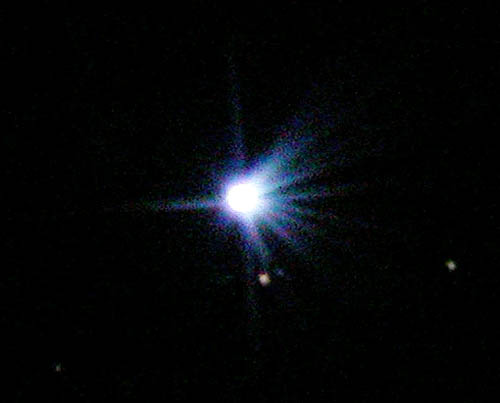 |
|
|
Castor (Alpha Geminorum) (Jan 16, 2005)
|
|
| Type: |
Aa: Main sequence star (Class A1V) /
Ab: Main sequence dwarf (Class M5V) / Ba: Main sequence dwarf (Class A2-5Vm) / Bb: Main sequence star (Class M2V) / Ca: Red main sequence dwarf (Class M0,5 V) / Cb: Red main sequence dwarf (Class M0,5 V) |
| Brightness: |
Aa/Ab: 1.96 mag /
Ba/Bb: 2.91 mag / Ca/Cb: 9.07 mag |
| Visual Distance (Separation): |
3.2'' / 72.5 " / 70.4"
|
| Distance: |
49.77 ly
|
| Colour: |
Aa: bluish white /
Ab: ? Ba: bluish white Bb: ? / Ca: reddish Cb: reddish |
| Luminosity (Sun = 1): |
Aa: 18.3 x
Ab: 18.3 x/ Ba / Bb: 14 x (combined) / Ca : 0.026 x / Cb : 0.026 x / |
| Mass (Sun = 1): |
Aa: 2.15
Ab: 2 x / Ba: 1.7 x / Bb: 0.4 - 0.6 x / Ca: 0.63 x / Cb: 0.57 x |
| Temperature: |
Castor Aa/Ab: 7,000 - 10,000 degrees /
Castor Ba/Bb: 7,000 - 10,000 degrees / Castor Ca/Cb: approx. 3,280 degrees |
| Diameter: |
Aa: 2.28 x
Ab: 2.28 x / Ba: 3.2 x / Bb: less than the Sun / Ca: 0.76 x / Cb: 0.68 x |
| Notes: | |
| Castor is a triple double star system and it's the 23th brightest star in the night sky. The two components of the brightest one of the three double star systems orbit each other within 9.2 days. The second brightest ones need 2.9 days and it takes the third brightest ones about 20 hours to finish a complete orbital rotation within a distance of only two solar diameters. | |